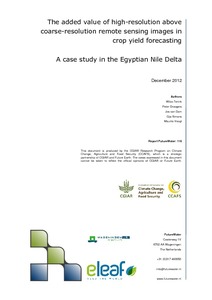Resource information
Crop growth models play a major role in sustaining the world-wide food security. These models are used to simulate crop growth during the growing season, and the final crop yield at the end of the growing season, given the farmers’ management practices. At a more strategic level, these crop growth models play an important role to decision makers to take timely decisions regarding food import and/or export strategies. The simulation accuracy of crop growth models relies on the quality of the input data. Since crop yield forecasting applications are often applied over large areas that rely on a spatially distributed crop growth model, the uncertainty in the spatial variation of the input data increases. Remote sensing images are often used in crop growth models because remote sensing images provide spatially distributed input data to these models. These images are available in numerous spatial resolutions, where coarse resolution images are often freely available compared to the more expensive high-resolution images. Therefore, the objective of the current study was to evaluate the added value of high-resolution satellite imagery above coarse-resolution satellite imagery in crop yield forecasting.


